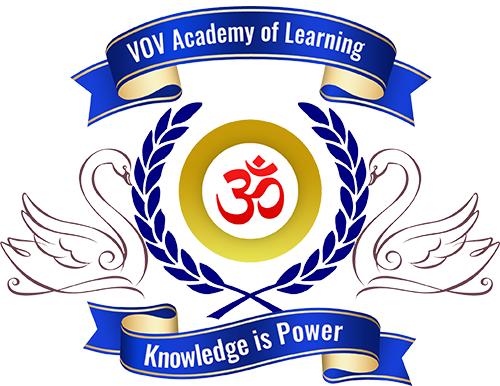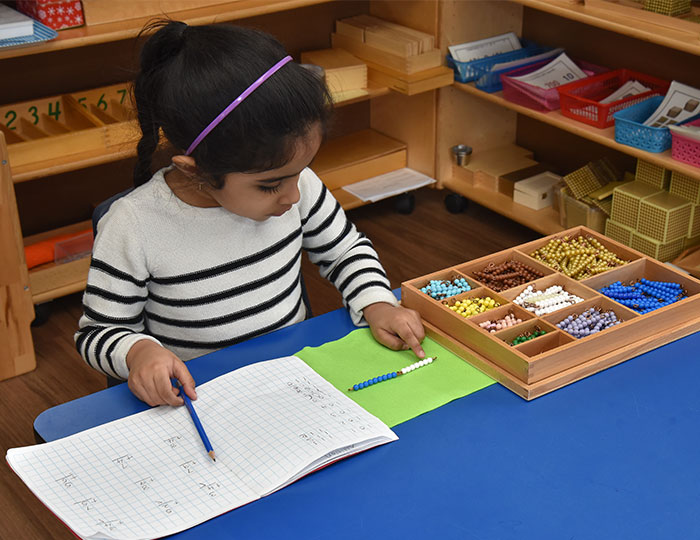The Montessori Advantage
The Montessori Curriculum
At the core of the Montessori Method is the Montessori Curriculum. The child-centered framework encompasses the holistic needs and interest of each individual child.
OUR MONTESSORI PROGRAMME ENCOURAGES children to grow and develop at their own pace, regardless of their age. Teacher guided activities are delivered on an individual basis and in small groups. Through this learning experience, children are able to gain the skills on how to take turns, listen to others, share their ideas, and unique experiences with one another.
Child Centred Approach Multi-aged settings
A child centered approach with mixed aged grouping encompasses a wholesome atmosphere where children work independently, learn from and share with one another.
The “Prepared Environment”
The Prepared environment is specifically designed with age-appropriate activities catered to their developmental needs. This presents opportunities for children to maximize independence and exploration.
Individualized Learning
Individualized learning in the Montessori approach helps children to develop skills through the use of purposeful, self-correcting, concrete materials develop by Dr. Maria Montessori. The materials invite each child to explore and learn at their own pace.
Hands-on Learning
Hands on Learning encourages children’s intrinsic desire to learn by sensorial experiences. Through this type of learning, the children expand their concrete understanding of the materials.
Practical Life activities are intended to help children enhance coordination and movement, gain independence, develop concentration, and adapt in today’s’ society. These activities include tasks which are familiar to the child; personal care, fine motor skills, grace/courtesy lessons, and taking care of the environment. The children achieve coordination and control of movement by exploration of his/her surroundings. They learn to complete a task from beginning to end by observing self-discipline, gaining the capacity to concentrate on their tasks and establish a strong sense of self by actively contributing to their environment. During the early years of development, imitation is one of the strongest desires as they observe and reflect on their surroundings. At this stage of development; children build a sense of trust, self-esteem, intelligence, and other etiquettes without being taught.
When children are captivated in an activity, they gradually build their concentration span. They learn to self-regulate and pay attention to details as they follow a regular sequence of actions. They attain a deep sense of learning through direct experiences with the materials used. The children acquire good work ethic as they complete each task and put away the materials before proceeding to a new activity.
As human beings, we explore the environment with our senses. As children utilize their senses, they build new and crucial pathways in their brain to strengthen pathways which are already established. In the Montessori classrooms, sensorial materials are designed to help children to categorize, distinguish, and relate new information to previously learned concepts. Dr. Maria Montessori described this phase as a more conscious stage of development where children developed the abilities to observe and compare with precision. Some of the sensorial materials utilized in the classroom are: pink tower, red rods, cylinder blocks, knobless cylinders, and the binomial and trinomial cubes which are used in preparation for geometry and algebra.
Sensorial materials aids in the development of children to refine their senses. Sensorial materials present experiences for children to focus on their visual discrimination of smell, size, basic weight, texture, flavour, colour, shapes, tactile impression- sense of touch, auditory sense, olfactory, and taste perception. In the preschool stage, when children are exposed to sensorial materials, they place order, and meaning to things. They heighten their capacity of perception by observing and gaining a sense of admiration for everything that surrounds them.
In the Montessori environment, the mathematical concepts are taught to the child through the use of concrete sensorial materials; in numeration, through process work, and additional math concepts. Through the manipulation of these concrete materials, the children learn to perform basic mathematical operations in counting, number recognition, and sequencing numbers.This sensorial experience of introductory math concepts will create a base for more abstract mathematical ideas later in their school life.
In the Montessori classroom, language is taught in different variations; by spoken language and through phonetic awareness. As children enter this environment, they expand on their acquired language through increased communication with teachers and fellow students. Through improved exposure to everyday language in daily routines; it builds on the groundwork for children to perfect their articulation, grammar, vocabulary, phrasing, speech, and sentence structure in order to freely express themselves verbally. In addition, phonetic awareness begins when the teacher introduces the children to the sensorial material of the sandpaper letters. The understanding of phonetic sounds helps the children recognize the sound of the consonant before applying it to their reading skills.
The application of the sandpaper letters and the movable alphabet support the children to learn the combination of letters and sounds to create words. The sandpaper letters allow the children to physically trace the shape of each letter with their fingers as they say the sound out loud. The movable alphabet harmonies symbols/sounds together in order to assist the children to begin creating words. This ability to put letters together to create a word is developed even before holding a pencil. This begins the intellectual component of writing.
In a Montessori classroom, writing opportunities begin before a child is even able to read. When these intellectual requirements of writing are met, children will become interested in using the movable alphabet to put into concrete form of the words. Through the use of activities such as the movable alphabet and nomenclature cards; the children can perform simple writing tasks. The more experience the child has with letter practice at building words, the easier it becomes. As children gain confidence with this process, their language abilities develop and they slowly begin to refine their spelling skills.
As children read their first words, they generally want to read everything! First, the children are encouraged to sound out phonetic words, which includes phonograms/digraphs at the same time; resulting in the introduction of high frequency words. These are called ‘sight words’ that don’t follow the rules and must be memorized. The teacher follows the pace of the child as they expand to non-phonetic words and then first-reader books. The children’s interests are cultivated, encouraged, and inspired to write and practice using the growing dictionary of words they can read. As children begin to extend their knowledge of language activities, they learn about geography, history, art, and music. These areas help the child to learn about his/her surroundings, to show respect, and love for their environment.
In a Montessori classroom, the exposure to cultural activities creates a backdrop for children to divulge in many different cultures from around the world. When the children experience cultural music, stories, and explore artifacts associated with a particular cultural background; they develop an appreciation and an awareness of the world around them. The areas of studies include biology, zoology, botany, geography, history, study of other cultures, and physical science.
The Montessori classrooms uses various medium of learning where children can discover the world around them. The children are introduced to the continents of the world, geographical location, and the provinces/territories of the country in which they live. Through the use of colour – coded globes and puzzle maps, flags of the world, the children can learn the shape of the earth, the land &water formation, and illustrate their own legend.
Our approach to history begins with the exploration of Matter, Energy, Space, and Time. The perception of “time” is abstract and the children’s relationship with time is highlighted through the use of concrete materials in individual and small group activities. The concept of the passage and cycle of time is conveyed through a series of simple activities. These activities begin with the calendar, the days of the week, the months of the year, and the introduction of the clock. The concept of Time Line is introduced through the exploration of the three fundamental tenses (past/yesterday, today/present, future/tomorrow). Time Line is a very long strip of paper which is unrolled and stretched along the classroom floor. The line is marked off in segments which represents various layers of periods in history. The curriculum emphasizes the study of historical people and post-modern people and cultures around the world.



















